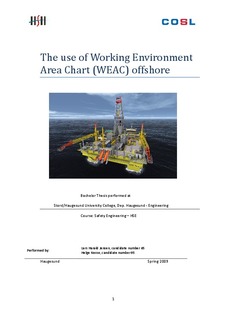| dc.description.abstract | The biggest industry in Norway is the petroleum industry. The industry holds a high standard on
health, environment and safety (HSE), but the work conducted offshore still involves potential risks.
To continually improve the HSE-work, the operating companies must meet requirements from the
prevailing regulations. To communicate risk it is important to consider how you adapt, design and
formulate risk messages. Good risk communication is defined by well aimed information adapted to
the receiver’s premises.
Through good management, risk-factors can be handled so that they do not constitute unwanted risk
to the health of the employees. The basic working environment charting is a systematic charting
which are to be carried out when a new work place is designed and when an existing work place is
being modified. The purpose is to ensure that the specific working environment requirements are
fulfilled. According to NORSOK standard S-002, Working Environment Area Chart (WEAC) or similar
must be used to document and improve the working environment. The objective of this standard is
to make sure that the projecting and construction of an installation contribute to a good working
environment in the operational phase.
The main purpose of the report was to investigate the use of WEAC on offshore installations. We
have, in collaboration with COSL Drilling Europe AS, looked at possibilities of improving the use of
Working Environment Area Chart in the operational phase, as well as investigated possible ways of
making individual risk aspects more visible. We performed a study of literature regarding the topics,
and further we conducted interviews with people of different professional background in the
petroleum industry. This was i.a. done by performing a questionnaire to create a picture of how
these parties execute and make use of area and work position-based charting for the working
environment,
During the project we discovered that little information existed on the topic, and this made us rely
most of our work on expert opinions and feedback.
WEAC seems like a good tool with respect of geographical focuses, i.e. working environment in an
area, but not so much for jointly working environment exposure on a group of workers. E.g.
mechanics will carry out work in various areas, and this demands a different approach to collect
information about their working environment exposure. It appears to be a handy tool when
measuring quantitative working environment factors such as noise, illumination and temperature,
but not so much with respect to qualitative factors as ergonomics and outdoor operations. This is
because the qualitative factors are hard to put in concrete terms in the chart.
A challenge with the local based information is to recover and trace historical documentation. In
general, from the companies contacted in this project, the WEACs are controlled, updated and
maintained by the onshore organization.
There have been several attempts on developing useful IT-based tools in relation of storage and use
of results of working environment charting. So far there has been little or no substantial success in
covering this object in combination with practical use. From feedback received in the questionnaire,
it seems like some of these specialized programs are too expertise demanding. Because of this they
may demand a higher level of computerized competence to keep the documentation updated and
maintained. The result of this may be that updating of the WEAC-system has to be carried out onshore. The best approach, in our opinion, is to make use of basic software, as for instance
Microsoft Word or Excel, and to develop a supplement base-application with respect to storage and
use of results of working environment charting. By utilize basic and well known software, one can
achieve well aimed information adapted to the receivers’ premises.
A Safe Job Analysis (SJA) may comply with the requirements in the NORSOK S-002 and the WEAC, and
connect it to everyday situations. The WEAC is connected to a specific working area, while a SJA is
carried out with respect to certain working procedures or operations. By making use of the WEAC
during a SJA, one may also incorporate the exposure to local based working environment factors.
It is our impression from working with the project that the WEAC is purely designed to meet
authority requirements, and its targeted groups have not been taken into consideration with respect
to user-friendliness. It is our opinion that the WEAC alone is not suitable as an information tool to
make the workers aware of the dangers they are exposing themselves to.
It is rather surprising that the NORSOK S-002 has been revised four times since 1994, but the WEAC
has remained more or less exactly the same. Because of the seemingly lack of knowledge amongst
quite a few of the people in the industry regarding WEAC, one could argue whether there should be
conducted an authority campaign to investigate the use of WEAC and its user-friendliness. | en |
